Aquatica D100 Housing
Aquatica AD100 for the Nikon D100 - First Impressions
Disclaimer: I am a part-time instructor for a dive shop that is an authorized Aquatica dealer. I receive no compensation for selling gear and I purchased the housing for personal use. Besides, I call them like I see them.
I have been eagerly awaiting the arrival of a D100 housing since my camera purchase last August. I have had the opportunity to shoot the D100 extensively topside since then, but have now completed my first underwater session with the camera and the new housing. The decision to switch to digital versus film and its related differences will be covered in another article.
Size Matters
Currently Digideep lists nine current or announced housings for the D100. These include custom aluminum housings from the more recognized manufacturers like Subal, Seacam, Nexus, and Aquatica and the one box fits many style of Ikelite and Sea & Sea. (Ikelite has not shipped a D100 housing as of yet, but was the first to ship a housing for the similar Fuji S2 camera. Sea & Sea departed from its custom aluminum housing design to a more "Ikelite" approach in order to allow easy adaptation, and hence shorter lead time, for other cameras. Light and Motion has come out or is coming out with their Titan housing for the D100, which is quite unique in its design. I chose to wait for a custom aluminum housing because I prefer the smaller footprint, both for underwater and packing considerations. I actually considered purchasing a Nexus D100 housing because its availability was supposed to be much earlier than that of Aquatica. It turned out not to be the case, so I not so patiently waited for Aquatica to ship their unit since I already had an investment in Aquatica ports.
My first impression was the similarity in design to my Aquatica A90 housing for the N90s camera. I believe that the similarity is even greater to the A100 (Nikon F100 housing). I don't have an F100 housing, but I find the D100 more similar to the F100 (which I own for topside use) in form and size than the N90s (the D100 is loosely based on the N80 film camera). The AD100 housing is definitely larger than the N90s, a good 1.5" taller and slightly deeper (to accommodate the LCD viewing screen). The housing was designed as a bit of a hybrid as it will allow modest design changes in order to accommodate other camera models, the Fuji S2 being the first D100 alternative. So, there is definitely some "excess" internal space. I've also included an apples and oranges comparison shot of the Nexus N90 housing for comparison. The Nexus housing may have the smallest footprint of any of the N90 housings I've seen and as you can see, the A100 housing is definitely larger. I'll cover the impact of this difference below.

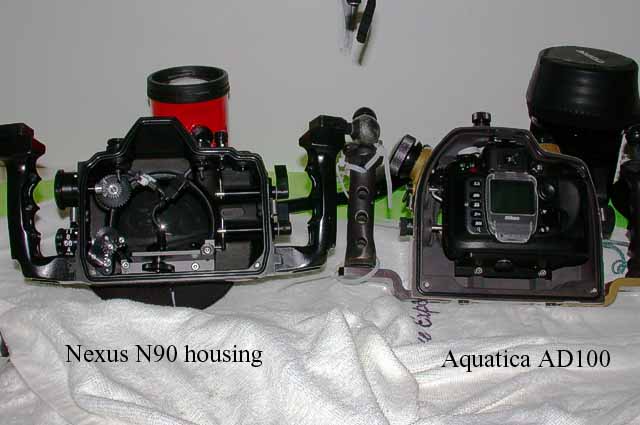
The Details and "Nits"
I'll start by discussing all the nitpicking details and shortcomings I faced on my initial setup of the system.
Manual? I don't need no stinking manual! My unit shipped without any instruction manual. The owner's manual wasn't ready at the time of shipping. No problem if you've ever used a housing before. Unlike the consumer digicams being housed, there are no special camera settings required prior to use. Simply pull up on the dial controls, line up the MSC switch, slide camera in the housing, screw base plate to camera (it is unnecessary to remove the base plate from the housing) and attach cable to hot shoe.
Let's talk about the those handles. The housing comes with handle base plates that are held in place with two counter synch screws. They fit very nicely onto the housing. The form fitted black handles then slide onto the handle bases and can be set to a range of distances from the housing to accommodate varying hand sizes, secured by a set screw. A great idea, but this is where I ran into my first problem. I couldn't get the handle to slide onto the base. Of course, I tried to force it to no avail. Even using my favorite tool, the rubber hammer, couldn't get it work. I went to the dive shop and grabbed the other AD100 unit off the shelf. The first thing I noticed was that my unit's handle base had the same gold finish as the housing, whereas the other unit's handle bases were just black epoxy coated aluminum. This extra finish may have created the tolerance problem, except that my forcing procedure eliminated both the gold finish and epoxy coating from the handle base. It looks like an early production tolerance problem.
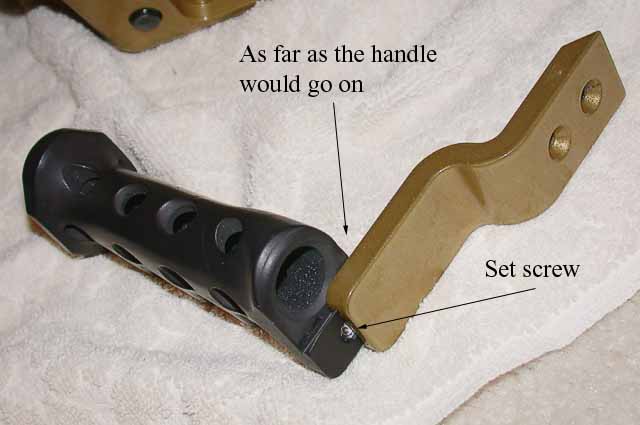
On to the next handle issue, set screws. I hate set screws! I have had a life long hate obsession with set screws. I have never trusted a set screw to secure anything that receives constant vibration or excessive torque. Aquatica loves set screws. They are also used to secure the shade to dome ports and also for focus gear attachment. I've collected at least a half dozen individual allen wrenches along the way that have accompanied my Aquatica parts. I've replaced all of those wrenches with a handy set that I carry with me. Thoughts of the arm sliding off with strobe arm and strobe attached kept creeping into my anxiety nightmares, although in reality the handles are quite secure. I did notice one handle had a front to back wobble, which helped feed my paranoia.
I currently use Ultra Light Control Systems arms on this particular system, although I plan on switching to Aquatica's TLC arm system. My set up includes 1" ball mounts attached to the handles via two screws. When I switched them from the A90 handles to the new AD100 handles, I realized they wouldn't fit. The threaded holes on the AD100 were closer together than on the A90, well for the most part that is. I had one handle that allowed the ball mount to attach properly. The other three handles had holes too close together. Not having the right tool handy to machine the ball mount opening, I resorted to the cable tie method.
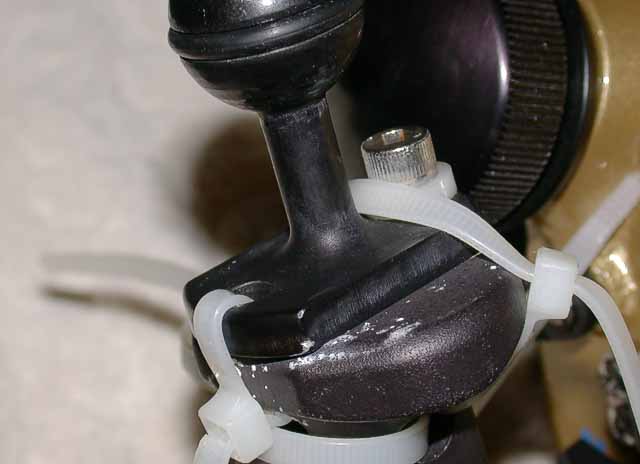
The housing has several blue painted symbols to help remind the user what each of the buttons/dials are there for. Once you close the camera, none of the labels on the camera itself are viewable. Space does not allow for all the controls to be marked, so one needs to be familiar with the camera before trying to use it in a housing. Curiously the on/off dial is marked incorrectly. Turning the dial clockwise turns the camera on. Of course, if you need the on/off markings to know how to turn your camera on, you need to spend more time with your camera above water before making the plunge. Unlike the actual clear labels that were used on my Aquatica A995 housing, which proved to be quite temporary, the markings on the AD100 are painted.
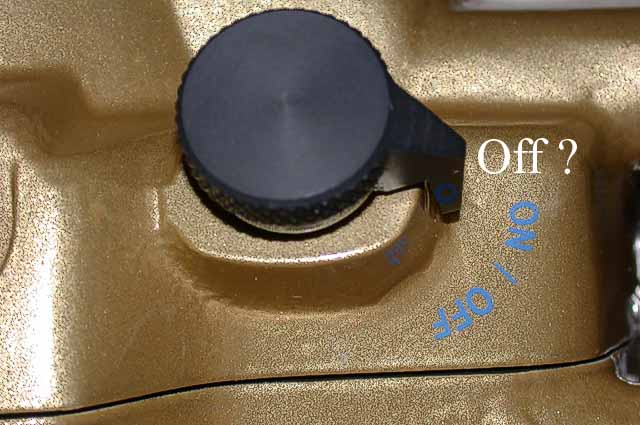
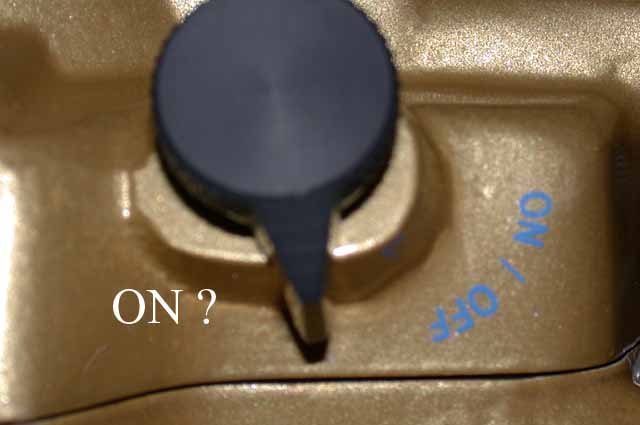
The D100's shutter release is inside the on/off dial, whereas the N90s had separate controls for the on/off and shutter release bottom. The on/off is controlled via a circular plastic piece that presses against the on/off ring of the camera. In order for the shutter release lever to reach the inner shutter release button, part of the circle is cut out. Oddly, my unit when the on/off dial is turned all the way clockwise (on) on my unit, the shutter release is blocked. It required me to back off the position until the shutter release would clear the on/off plastic circle.
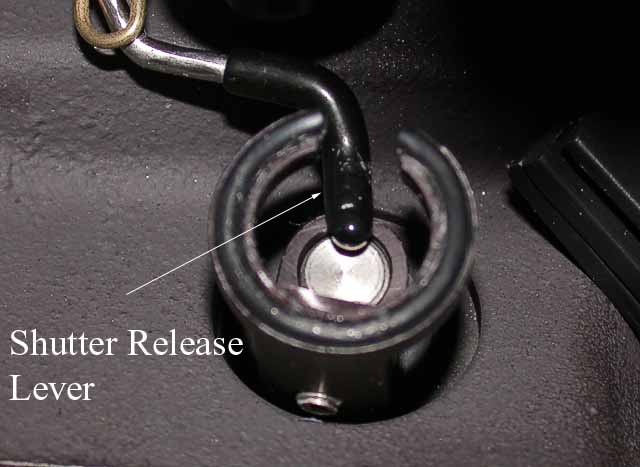
The shutter release is controlled via lever with spring. Unlike the A90, the spring is fully exposed and non-adjustable. The second unit's spring was misaligned, which required me to take the shutter release mechanism off of the housing and re-assemble it properly. I consider this a weak point in the design as it may be easy to damage or lose alignment of the spring. However, I experienced no problems or difficulties in its use.
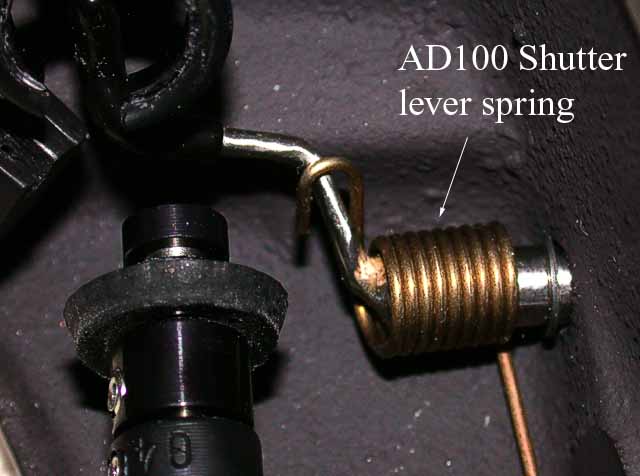
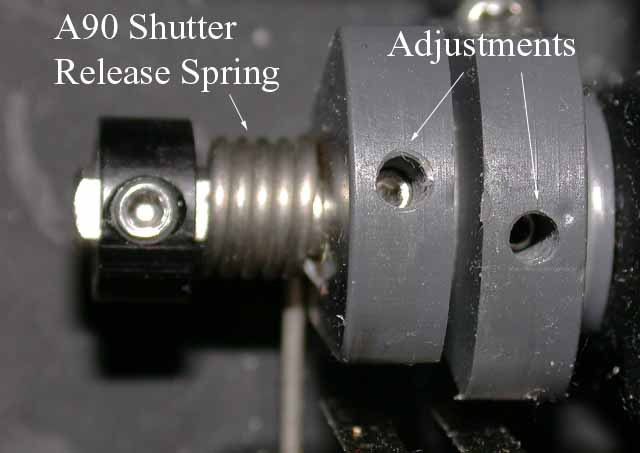
The unit ships with one Nikonos bulkhead and the optional second Nikonos bulkhead. This is no different than any of the other housings out there, save Ikelite. I hate Nikonos connectors. These odd shaped deeply recessed curiosities kind of made sense on a Nikonos camera, but just seem infinitely inferior to a good, solid, idiot proof Ikelite connector. Unfortunately, even though Nikon has abandoned the underwater world, their bulkhead connector remains the standard. While the connector can be swapped out for the Ikelite version, I probably won't bother with the added expense, plus I have a box full of Nikonos to Ikelite synch cords.
A slightly different view through the viewfinder. The AD100 has a slightly larger circular viewfinder than the A90. As best I can tell, there must be a modest amount of space between the rear AD100 viewfinder and the camera's viewfinder. I immediately noticed some stray light bouncing around the inside of the camera finding its a way into my line of sight. I don't find the D100's viewfinder up to par with either the N90s or F100 anyway. Any negatives about the viewfinder may have more to do with the camera than the housing.
The Important Issues
Now that I've nitpicked all the little details, it's time to move on the real issues. The areas I look at in evaluating a housing are as follows:
-
Ease of setup
-
Functionality of Controls
-
Balance and handling underwater
-
Port system and options
-
Price/Value
Ease of setup. This unit shines. The permanent placement of the base plate allows easy installation. No more carrying my camera around topside with the base plate still attached. It uses the same two latch system as previous Aquatica models, easy to close, a little harder to open with handles close in (I've got short fingers). My A90 unit has a ridiculously long ribbon cable that attaches to the hot shoe. This made it easy to close the housing with the cable sticking outside the camera (flood!) or when jammed inside the housing to interfere with gears or push the hot shoe connector slightly out of alignment. The AD100's cable is just the right length. Accessing the CF card is no problem. The camera must be unscrewed from the base plate to change the battery, but this is a very simple process. There are no accessory eyepiece attachments for the viewfinder. The unit also has a new control lever that depresses the lens release button on the front of the camera when switching lenses. This was greatly appreciated when removing the very wide 17-35mm lens. With the A90, I would use a screwdriver to reach the button, since my short thick fingers couldn't fit in between the port hole and the lens. The protective plastic cover for the LCD screen did not need to be removed (and probably lost). I rate it an A.
Functionality of Controls. Again, this unit shines. All camera controls are accessible and perform flawlessly. I hate to admit it, but I was apprehensive after my Aquatica A995 housing experience. There wasn't much I liked about that particular housing. It was Aquatica's first foray into digital and suffered from several flaws. The A5000 for the Nikon CP5000 turned out to be a beauty of a housing that exceeded my expectations. The AD100 also exceeded my expectations as far as functionality is concerned. I try to use as few camera functions as possible underwater, but at some point I needed to use most of them and they were both easily recognizable and easily manipulated. The LCD monitor was quite easy to see and using various controls on the fly became second nature, although using the rear command dial knob required removing your hand from the handle to turn the knob. The zoom gear for the 17-35mm mated easily with the control gears of the housing and zooming in and out with my left hand still around the handle was quite easy. I rate it an A+.
Balance and Handling Underwater. As I mentioned earlier, size matters to me. Possessing a chronic pinched nerve problem in the back and other shoulder/knee ailments makes carrying and pushing a camera underwater a potentially painful experience. All those streamlining techniques go out the window when pushing a housed SLR with strobes flared out through the water and/or fighting a current. The "honey, hold my camera for a minute" only worked once. I've heard people complain about the bulk of an Ikelite housing for their diminutive digital camera, yet it is smaller by far than any 35mm housing, film or digital. If you've never dived with one, it takes a little getting used to after using a smallish camera like a Nikonos.
The AD100 is a little heavier than the A90 and slightly negative in the water. With two strobes attached, the unit is definitely negative. It is reasonable well behaved, but definitely top heavy, which causes it to want to tip forward. Again, the AD100 is taller than the A90. This creates a little more drag in the water. The tendency to fall forward was most noticeable with the A90 when I had a long heavy lens, like the 200mm, with its long heavy lens port and strobes positioned forward and above. The unit needed to be cradled with the left hand under the port. (This is an area where the larger, big box Ikelite housings have an advantage. They have lighter ports and present a more balanced rig. But the downside remains their overall girth.) The AD100 tended to lean forward with any setup. Maneuvering through the water and approaching subjects was not a problem. Adjusting controls on the fly was again a snap and there was no confusion about what buttons/knobs controlled what. I would rate it a B, although I wonder how much better any unit could be given the nature of the camera.
Port System. The housing manufacturers that have already been producing housings have designed their D100 housings to accept their existing ports. This is a big plus for both the consumer and manufacturer. I have already collected an assortment of ports and port extensions for the A90 and switching to the AD100 meant no change in port selection. It is important to evaluate available port options in choosing a housing. It is easy to spend half again the price of the housing on ports. One of the reasons for switching from Ikelite to Aquatica was the port system. Aquatica has both a 6" and 8" dome available, although I'd be hard pressed to find a reason to go with the 6" dome. The 8" dome handles all the wide angle prime lenses, including the 16mm fisheye lens. I also carry an extension for the bigger, longer, wider 17-35mm lens. This has become my lens of choice for wide angle for now. The 60mm flat port can be combined with extensions in order to use the 105mm, 200mm and 70-180mm macro lenses. When I was using the Ikelite housing, I would have had to carry separate ports for most of the above lenses. While not expensive, it could be a packing nightmare. Also, I've never had to use diopters with any of the port/lens combinations. The ports use a bayonet style mount. Secure, but always check your ports before entering the water!
Each manufacture has its own list of available ports. Some are quite impressive. Seacam, for example, has four distinct dome ports, all made from mineral glass. I think this is ideal. In a perfect world, you would use a separate dome port optimized for a specific lens. But, alas, I don't wish to have to pack up to three dome lenses costing as much as $3500. The single 8" dome works well for me with all the lenses I shoot. The digital crop associated with the D100/S2/Canon 10d actually eliminates most or all of the edge softness, but that's another subject. The issue of glass versus acrylic ports is another issue I will skip. I prefer to let others argue about such things. Aquatica can provide glass versions of their flat ports if you insist.
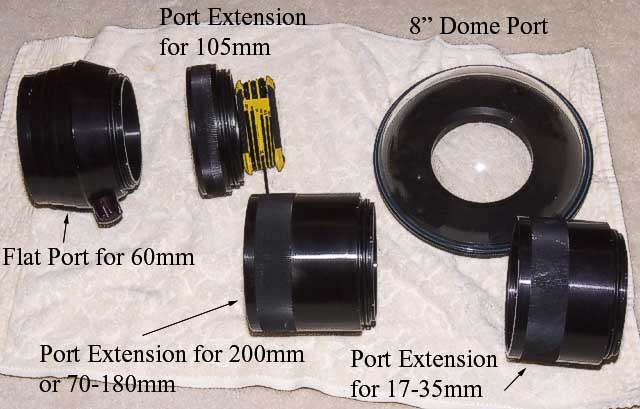
The Aquatica web site lists port compatibility under the A90. This list hasn't been updated since the first Gulf war, I think. But, newer lenses are supported. Contact Aquatica or an Aquatica dealer for specific lens support. I would rate the port system an B+ or an D if you are true believer in optical glass ports. Port extensions are relatively expensive. They are one of those things you stare at and say, "How can it cost that much?"
Value. After all the topics have been covered, how does it stack up versus the price? Here, I have no hesitation in giving it an A. The MSRP for the AD100 is $1899 (far less than say $1900). Of the housings readily available in the western hemisphere, it is quite comparable to the Sea & Sea housing, a one size fits many design and non-aluminum. I have not gotten up close and personal with other manufacturers' D100 housing, but based on their previous offerings, I expect both high quality and functionality. The other housings from well known suppliers are anywhere from $500-$1000 more expensive. Their port systems are also more expensive. If ports are needed, the total package price of the AD100 is typically $1000 or more lower. This, combined with great functionality and performance (previous nits aside), make it an excellent value. Of course, if one is already invested in a port system from one manufacturer, sticking to that manufacturer makes a lot of sense.
When Ikelite starts delivering its D100 housing, the price/performance measurement may need to be re-evaluated. It will definitely be less expensive (how much so is not clear), but there may also be some significant performance trade-offs, perhaps that same ones that caused me to switch with the N90s. The Light and Motion Titan housing offers a much different comparison. While more expensive than the Aquatica offering, it stands alone in terms of design features. It provides electronic camera controls built into the housing handles and its ROC strobe controller is quite unique. The issues of strength, durability and complexity remain (there are now two primary electrical failure points, the camera and the housing), but time will tell.
Summary
The review above included my observations and opinions on the Aquatica AD100. I believe the unit delivers everything I expected and maybe a little bit more, despite some quality nit-picking (my unit was serial #6) and at a price that is very competitively priced. If I didn't believe it, I wouldn't use it. I'm personally not that price conscious, but I can't ignore the price point issue for any potential consumer. Maybe other more expensive offerings are better. I can't say. I'm sure someone will let me know. I do know that I am now a happy underwater D100 digital shooter and have all the housing I will ever want.
Now, am I happy shooting the D100 underwater versus my film camera? That's another story. Stay tuned.
view sample gallery from Palau